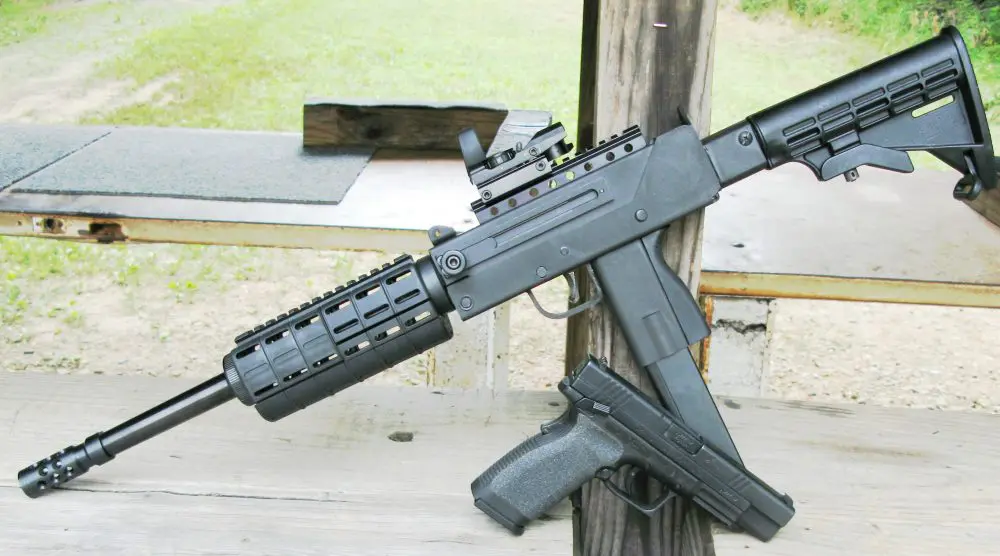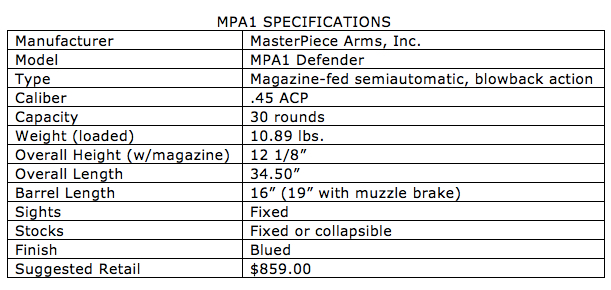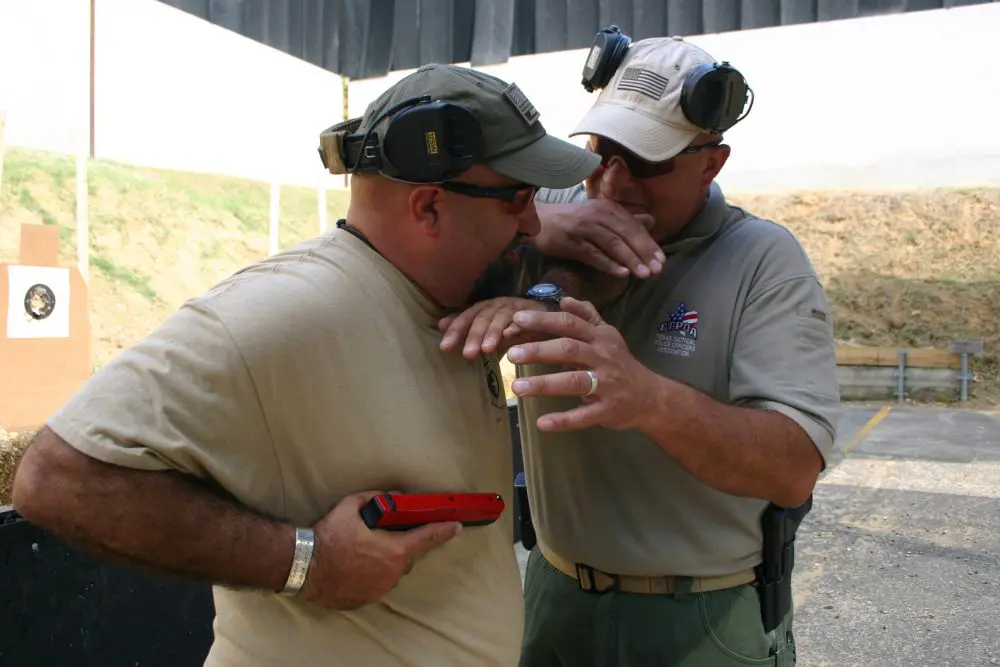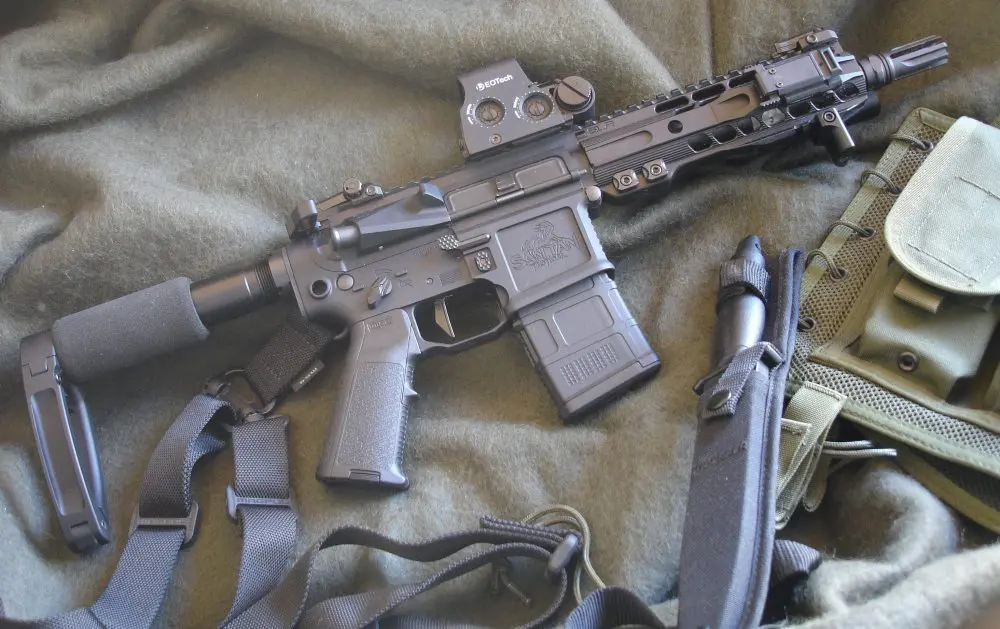Improve on a 45-year-old design, and what do you get? You get a Super Ingram pistol or rifle from MasterPiece Arms, Inc.
While its basic blowback and telescoping bolt internals remain close to the original, the MPA1 Defender series features some interesting changes. It is now a closed-bolt rather than a blowback system, which makes the gun more stable during ignition of the cartridge.
However, the idea of modifying Gordon Ingram’s creation and creating a long gun out of what started as an ultra-compact machine pistol or “pocket machine gun” is not new, and its inventor produced a few rare versions with 18-inch barrels.
The Military Armament Corporation (commonly called “MAC” or “Ingram” after the inventor) M10 handled 9x19mm and .45 ACP, while the M11 in .380 ACP was specifically designed to be operated with a suppressor.
All of them were considered bullet hoses and very difficult to control sans suppressor and extended shoulder stock, because their cyclic rates were exceptionally high (1,100-1,200 rounds per minute).
Depending on the caliber, configuration and mode of fire, maximum effective range varied from 30 to 70 meters. Range and accuracy limitations were also imposed by crude fixed sights with a relatively short radius and light weight (3.50-6.25 pounds). With the MasterPiece Arms (MPA) rifle system, effective hits out to 100 yards on man-sized targets are readily attainable by an average shooter.
MPA1 Defender and XD .45 ACP Tactical pistol. Note side-cocking lever, NcStar holosight and muzzle brake.
Table of Contents
CHANGES AND ACCESSORIES
Perhaps capitalizing on the fact that very few of Mr. Ingram’s desirable carbines exist today, MasterPiece Arms’ MPA1 Defender offering comes with a 16-inch threaded barrel and is available to civilians in semiautomatic only.
What is most interesting is that both long and short gun versions can be obtained with Ingram’s traditional dorsal cocking handle or MPA’s proprietary portside cocking lever.
Three different solid stocks are available. In addition to the basic fixed skeleton stock, iron-sights-only versions come with a slightly angled down AR-15 style collapsible stock to make acquisition of the low profile fixed sights more comfortable. However, if you prefer the system equipped with factory optics, the affixed stock will be a horizontal affair similar to those found on the ubiquitous AR-15/M4 platform.
With the side cocker, the upper receiver’s topside can be fitted with a rail to mount all manner of sights and accessories to bring the gun into the current small arms millennium. MPA has thoughtfully included a multi-reticle red dot sight to further enhance accuracy and target acquisition speed.
Defender’s trigger boot.
The barrel, tipped with a multi-ported removable muzzle brake, is shrouded by a beefy Intrafuse AR-type foregrip with four hidden rails. The foregrip can be further embellished with a vertical Intrafuse grip with storage area similar to those that have become popular with our M4 carbine drivers throughout the military by simply sliding a lower panel forward and off.
This extended barrel system reaches well into the receiver and is surrounded by its massive bolt. The bull barrel with its foregrip system has a removable 120 lumens tactical light that replaces the old lower receiver loop strap, which was of dubious stability value.
Like the original, the safety is located on the frame’s port side in front of the trigger and must be rotated by the right hand’s index finger 180 degrees toward the shooter to unlock the trigger.
The entire kit comes in a sturdy and lockable padded hard case. However, the gun cannot be stored in its case with its NcStar sight mounted. It must be removed and possibly re-zeroed every time it is remounted if the case is used. As with any rail-mounted accessory, mark the rail once you establish desired eye relief. The only item missing from this hefty piece is a sling system—prolonged carry by even a Rambo will dictate one.
Defender’s muzzle brake.
NCSTAR RED DOT
The NcStar red dot sight is really neat. Its big, anti-glare coated window makes fast, heads-up target acquisition a cinch. Powered by a three-volt lithium battery, it is fully adjustable and has seven different intensity settings with four different CQB and long-range reticules—dot, cross hairs, circle/dot and circle/dot/crosshairs. Depending on the intensity, selected battery life is variable, and the rail mount tunnel allows emergency acquisition of back-up iron sights.
MASSIVE MAGAZINES
As with the original M10, the ergonomic grip accepts M3A1 “Grease Gun” 30-round big sticks, so supplies of these should be adequate as long as you know where to look. Cost should run around $35. The current MPA1 system and magazine followers do not hold the bolt open when the last round is expended, but the factory is working on a lighter polymer magazine that may support such a feature in the future.
The M3 magazine is ten inches in length, and half of it protrudes from the magazine well. Consequently, one is forced to assume a high, body-exposing prone when going to ground with the weapon.
The magazine release is actuated by pressing in a mag catch located at the base of the pistol grip with your support hand thumb.
The manual implies that the magazine comes with a mag loader. Unfortunately, it does not, and for those of you who have experienced Grease Gun-loading thumb, it is a much appreciated accessory and can be obtained at extra cost from MPA.
MPA1’s massive bolt compared with size of XD Tactical pistol’s bolt.
FIELD ACCURACY
Accuracy tests were conducted at 50 yards with seven different commercial rounds ranging in weight from 85 to 230 grains. International Cartridge rewarded me with a group of 2.01 inches at 50 yards. The worst was obtained with Le Mas CQB IV at 12.50 inches. After the first round, which was dead center, the remaining four rounds spread out to the right of the target. Because of its hypervelocities and light weight, Le Mas may require a different ratio of rifling to enhance accuracy.
I decided to repeat some of these tests without the muzzle brake in place to see if it had any effect on groupings and if it actually attenuated recoil. Changes in felt recoil were not noticeable, and muzzle flash was not elevated. However, accuracy deteriorated.
HEAVY VS. LIGHT BULLETS
Four conventional bullets of different weights were fired into Perma–Gel (PG) ballistic test media to compare pistol bullet performance from a longer barrel.
Normally, heavier bullets will produce deeper penetration. However, in this case the 160-gr. CorBon DPX tore a 16-inch wound channel into the PG, which was 1.5 inches deeper than the Winchester 230-gr. HP. Nevertheless, the latter type “T” projectile expanded more dramatically, to over one inch in diameter, and created a much larger wound cavity than the DPX. The composite International projectile fragmented like a rifle bullet within the first eight inches of penetration, with one tiny fragment traveling 16.5 inches.
Agent fires MPA1 for accuracy. Round is being chambered.
.45 ACP TRUMPS 5.56x45mm
Three loads went supersonic—1,116.13 feet-per-second (fps) at sea level—and a definite ballistic crack was evident. With CorBon’s DPX round, the Defender and five-inch XD pistol pumped it out at 1,236 fps and 1,185 fps respectively.
I mused to myself that maybe a 16-inch runway was overkill as far as increased velocity was concerned, and initial firings indicated a gain of only 50-80 feet per second with the longer but civilian-legal barrel length.
The highest velocity of 2,693 fps with 1,369 foot-pounds of muzzle energy was obtained with Le Mas CQB IV police/military ammunition, which easily perforates LIIIA body armor and is capable of defeating a ¼” sheet of T-304 stainless steel. After literally burning through a sheet of 14-gage cold rolled steel, the 85-grain round screamed across the entire length of the 19-inch PG block and slammed into the Kevlar trap.
Consisting of the bullet, its polymer “kicker” and annealed steel plug, the .68-inch projectile was too hot to pick up. Most of the bullet’s shed .70-inch jacket was welded to the rim of the crater created upon penetrating the steel, and the PG entry point was scorched black. The face of the steel plug hit the Kevlar so hard it bore the colored imprint of its weave. The PG was warm, so the Le Mas round fragmented and a second substantial projectile veered off an inch from the primary wound tract and penetrated seven inches.
The round’s combination of bullet weight and high velocity actually eclipses the 62-gr. 5.56x45mm M855 round in short-range kinetic energy by 169 foot-pounds. Green Tip, when fired from the 15-inch barreled Colt Special Purpose Rifle, typically achieves a muzzle velocity of 2,960 fps and 1,200 ft. lbs. Obviously, the Le Mas CQB IV would make a very lethal short-range load for a police pistol-caliber patrol carbine.
Even though it has a “loose” chamber, the Defender definitely prefers some rounds over others. Federal 185-gr. Hi-Shok, with its wide exposed lead tip refused to consistently chamber and frequently had to be single round fed and fired.
The Defender has loose tolerances, but later on, as the gun got dirty, even ball rounds had to occasionally be coaxed into battery. This type of weapon should run under extreme field conditions. Upon factory examination, the problem was attributed to a weak magazine spring. Masterpiece has instituted quality control procedures to mitigate this problem.
Snap shooting and shooting on the move were conducted from ten yards. Note ejected brass.
ROBUST RIFLE
A bit cumbersome, the Defender will not only hit with big-bore authority, but will also build muscle. At 10.69 pounds loaded, the rifle is not for wimps. It weighs slightly less than the Russian RPK light machinegun. However, its beefiness compensates for itself by reducing recoil to an absolute minimum. Felt recoil is mostly a manifestation of its big bolt slamming into the recoil plate and rubber shock buff resting against the receiver.
With a trigger pull weight of approximately five pounds and take up, effective semiautomatic volleys are limited by your neuromuscular trigger-finger dexterity. So-called “bump fire” aficionados will love to achieve near full-auto cyclic rates with the gun. If you can afford it, go for it, but 30 scarce and costly rounds can easily be squirted away in seconds. Steel gun traditionalists will also appreciate the Defender’s robust construction. Curiously, the trigger has a plastic “trigger boot” for protecting the finger during strings of rapid fire.
FUTURE AND CONCLUSIONS
In the future, in addition to full-auto versions (should there be demand), MPA will offer a .22-caliber conversion kit or stand-alone sub-caliber model.
In my opinion, the Defender should be tuned to reliably feed all .45 ACP cartridge configurations. It must also shed weight: this could be accomplished by reducing barrel diameter or fluting and incorporating a polymer magazine.
The efficacy of the muzzle brake is also in question, because little difference in felt recoil was experienced with or without it.
However, for those who may have an interest in things Ingram and are looking for a complete shoulder weapon package at a price hundreds of dollars lower than AR-15 weapons, look no further than the Defender.
SOURCE:
MasterPiece Arms, Inc.
Dept. S.W.A.T.
P.O. Box 669
Braselton, GA 30517
(866) 803-0000
www.masterpiecearms.com













